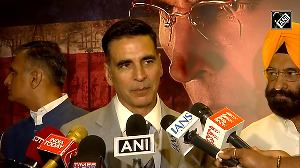Taking the route to meet basic needs and aspirations of the 'aam aadmi', the finance minister has once again outlined major outlays in his Budget for 2006-07.
A large number of budget proposals are aimed towards the rural economy and high investment for long-term sustainable growth. Despite high allocations on these heads, the FM aims to maintain fiscal discipline.
Simply put, he has projected revenue and fiscal deficit of 2.1 per cent and 3.8 per cent respectively for 2006-07, lower than the 2.6 per cent and 4.1 per cent levels likely to be achieved in 2005-06.
In this article, we try and understand the financial statement of the Central government and gauge through the major heads of income and expenditure as planned for 2006-07.
India: Financial snapshot
| 2005-06 | 2006-07 | |||
| (Rs bn) | Budget | Revised | Budget | Change |
| Revenue statement | ||||
| Tax revenue | 3,700 | 3,701 | 4,422 | 19.5% |
| Corporate Tax | 1,106 | 1,036 | 1,330 | 28.4% |
| Income Tax | 662 | 662 | 774 | 16.9% |
| Excise | 1,215 | 1,120 | 1,190 | 6.3% |
| Service Tax | 175 | 230 | 345 | 50.0% |
| Customs | 532 | 642 | 771 | 20.0% |
| Others | 10 | 11 | 12 | 4.8% |
| Less: Adjustments* | 966 | 960 | 1,149 | 19.7% |
| Net tax revenue | 2,735 | 2,741 | 3,272 | 19.4% |
| Non-tax revenue | 777 | 743 | 763 | 2.6% |
| Centre's revenue | 3,512 | 3,485 | 4,035 | 15.8% |
| Expenditure statement | ||||
| Non-plan expenditure | 3,708 | 3,649 | 3,913 | 7.2% |
| Interest payments | 1,339 | 1,300 | 1,398 | 7.5% |
| Defence | 830 | 817 | 890 | 8.9% |
| Subsidies | 474 | 469 | 462 | -1.4% |
| General services | 408 | 423 | 453 | 6.9% |
| Social services | 75 | 93 | 85 | -7.9% |
| Economic services | 119 | 127 | 118 | -7.0% |
| Other | 462 | 420 | 506 | 20.5% |
| Plan outlay | 2,113 | 2,053 | 2,540 | 23.7% |
| Centre's expenditure | 5,821 | 5,703 | 6,453 | 13.2% |
| Deficit | (2,309) | (2,218) | (2,418) | 9.0% |
The main reason for the FM's lower revenue deficit estimate is his expectations of higher tax and non-tax revenues this year than was estimated in the earlier budget (see table above). However, these expectations carry a big caveat.
When we break up the tax revenue as estimated in this year's Budget, the top contributor i.e. corporation tax (around 30 per cent of tax revenues), is likely to rake in growth of 28 per cent over the revised estimate of 2005-06.
This, the government has assumed on account of high growth of the Indian economy and rising profitability of Indian corporations. Overall, tax revenues are expected to grow by nearly 20 per cent.
Now, even when we consider any marginal slowdown in the Indian economy, a less than 20 per cent YoY growth in tax revenues does not seem lofty. This is considering the fact that in the last decade, the highest growth in tax revenues stands at 23 per cent (achieved in 1999-00) and the average growth has been around 15 per cent.
On the expenditure side, interest payments and debt servicing (36 per cent of non-plan expenditure) continues to rule the roost, with the same expected to grow by 7.5 per cent in 2006-07. This has cast huge pressure on the finances of the earlier governments, and with interest rates on the rise combined with large-scale investment plans, it might have a negative affect on the future numbers as well.
What is noteworthy of this year's budget proposals is a huge increase in plan outlays (24 per cent YoY growth estimated). Major investment is proposed in agriculture, energy, transportation, communication and social services segments.
However, while the absolute numbers might look humongous, one should note that the government spends just around 10 per cent of its total expenditure towards real human development, which includes education, employment, social services, health, income and social security.
While factors like acquaintance with the English language and high levels of technology skills will play a very vital role in the growth of the Indian economy, sustenance in this growth can only be brought about by addressing basic needs of the populace.
India has been a laggard on some of these human development factors. Also, due to a huge workforce and inability in proper distribution of wealth, a large proportion (around 35 per cent) of India's population is poor. These factors, if not taken proper care of, are likely to ruin India's chances of building up a solid and sustainable growth model for the future.
On an overall basis, the Union Budget for 2007 has aimed at playing a balancing game. In terms of managing finances better, the budget has laid emphasis on focusing expenditure on select (human development) priorities while expecting to grow its revenues at a decent rate. The budget has also seemingly laid out a long-term plan for the Indian economy.
Importantly, as a strong measure of disclosure, the budget has identified a roadmap for managing results and achieving them.
These things spell positive vibes for the Indian economy. However, as always, implementation will be the key.
Equitymaster.com is one of India's premier finance portals. The web site offers a user-friendly portfolio tracker, a weekly buy/sell recommendation service and research reports on India's top companies.








 © 2025
© 2025